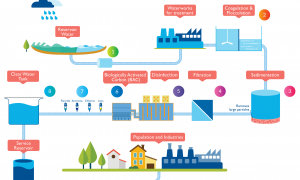🕑 Reading time: 1 minute
Intake structures are used for collecting water from the surface sources such as river, lake, and reservoir and conveying it further to the water treatment plant. These structures are masonry or concrete structures and provides relatively clean water, free from pollution, sand and objectionable floating material.
Contents:
Site Selection for Intake Structures
- The site should be so selected that it may admit water even under worst condition of flow in the river. Generally, it is preferred that intake should be sufficiently below the shore line.
- Site should be very close to treatment plant as possible.
- It should be so located that it is free from the pollution. It is better to provide intake at upper stream of city so that water is not contaminated.
- It should not interfere with river traffic, if any.
- It should be located where good foundation conditions are available.
- It should be so located that it admits relatively pure water free from mud, sand and pollutants. Means it should be protected from rapid currents.
Types of Intake Structures
Intakes are classified under three categories: Category 1:- Submerged intake
- Exposed intake
- Wet intake
- Dry intake
- River intake
- Reservoir intake
- Lake intake
- Canal intake
1. Submerged Intake Structures
- It is the one which is constructed entirely under water.
- It is commonly used to obtain supply from a lake.

2. Exposed Intake Structures
- It is in the form of a well or tower constructed near the bank of a river, or in some cases even away from the river banks.
- Exposed intakes are more common due to ease in operation.

3. Wet Intake Structures
- It is a type of intake tower in which the water level is practically the same as the level of the sources of supply.
- It is sometimes known as Jack well and is most commonly used.

4. Dry Intake Structures
- In case of dry intake there is no water in the water tower.
- Water enters through entry port directly into the conveying pipes.
- It is simply used for the operation of valves etc.

5. River Intake Structures
- It is a type of intake which may either located sufficiently inside the river so that demands of water are met with in all the seasons of the year, or they may be located near the river bank where a sufficient depth of water is available.
- Sometimes, an approach channel is constructed and water is led to the intake tower.
- If the water level in the river is low, a weir may be constructed across it to raise the water level and divert it to the intake tower.


6. Reservoir Intake Structures
- When the flow in the river is not guaranteed throughout the year, a dam is constructed across it to store water in the reservoir so formed.
- These are similar to river intake, except that these are located near the upstream face of the dam where maximum depth of water is available.
- Design of intake may vary based on the type of dam.


7. Lake Intake Structures
- Generally submerged intakes are preferred for lake intakes.
- These are constructed as cribs or bell mouths. The cribs are made of heavy timber frame work which is partly or wholly filled with rip-rap to protect the intake conduit against damage by waves etc.
- The top of the crib is covered with cast iron or mesh grating.

8. Canal Intake Structures
- In some cases, source of water supply to a small town may be an irrigation canal passing nearer or through the town. Then it will be constructed.
- Generally it consists of masonry or concrete intake chamber of rectangular shape, admitting water through a coarse screen.
- A fine screen is provided over the bell mouth entry of the outlet pipe.
- The intake chamber may be constructed inside the canal bank if it does not offer any appreciable resistance to normal flow in the canal.
- It’s preferred to provide lining to the canal near the intake chamber.





